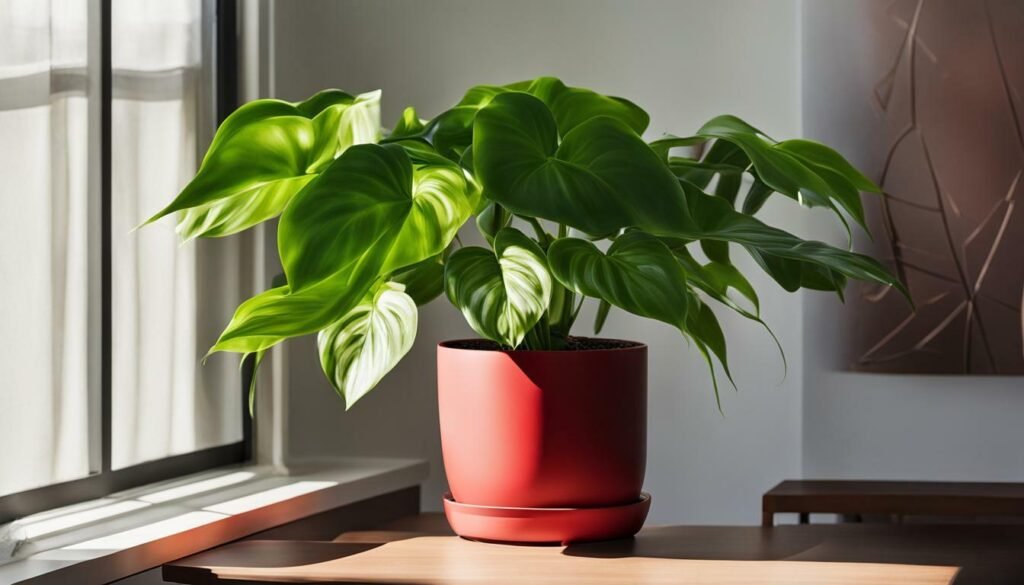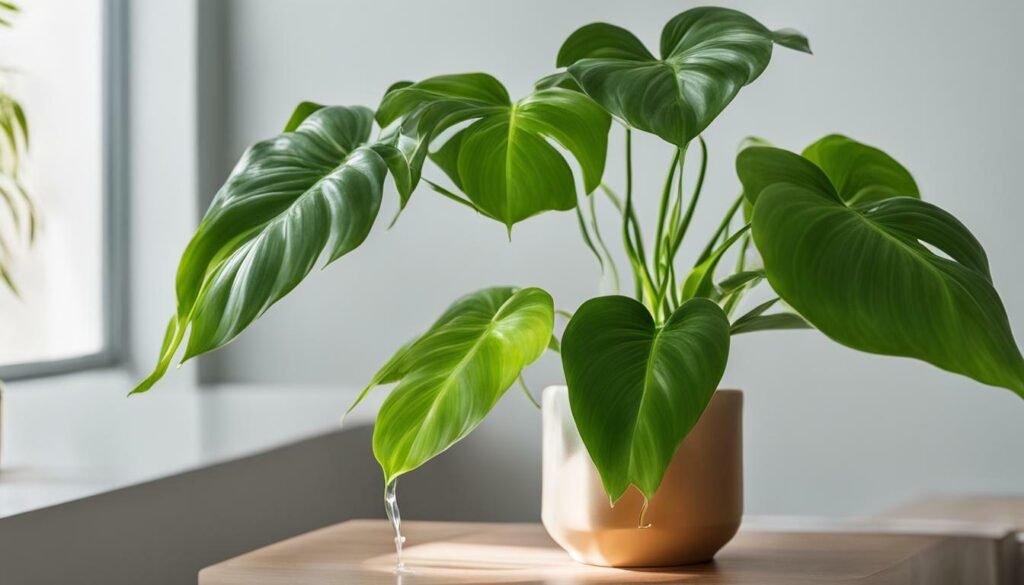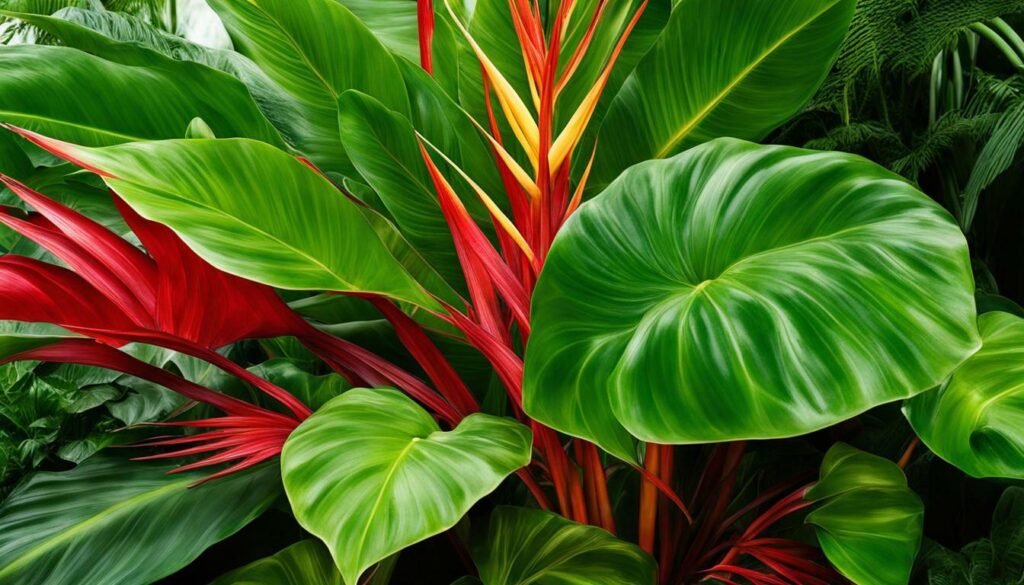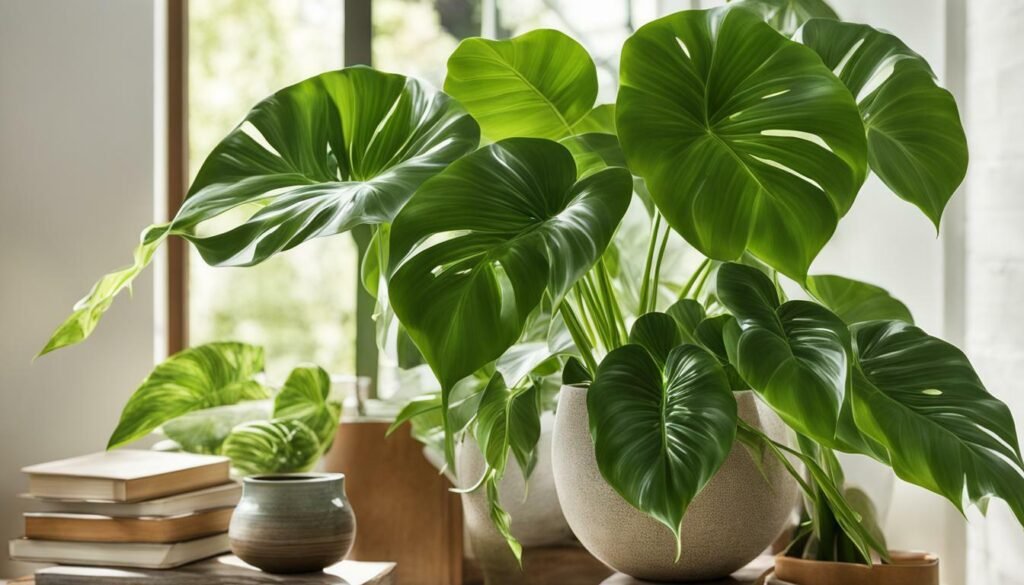Welcome to my guide on maintaining and caring for the stunning Philodendron ‘Squamiferum’. This rare houseplant is a favorite among indoor plant enthusiasts, and in this article, I will share valuable tips to help you keep your Philodendron ‘Squamiferum’ thriving.
Table of Contents
ToggleKey Takeaways:
- Philodendron ‘Squamiferum’ is a rare and easy-to-grow plant with attractive foliage.
- It requires medium to bright indirect light and high humidity levels around 40%.
- Water the plant when the top few inches of soil dry out.
- Grow it in organic, well-draining, and slightly acidic soil.
- Fertilize once every 1-1.5 months during the growing season.
- Prune to remove old or damaged leaves and propagate through stem cuttings or seeds.
- Common issues include crispy leaf tips, leaf yellowing and browning, root rot, pests, and brown leaf spots.
- Take caution as the plant is toxic to both humans and pets.
About Philodendron ‘Squamiferum’
Philodendron ‘Squamiferum’ is a rare and captivating tropical plant that stands out among other Philodendron varieties. With its climbing growth habit and lobed leaves, it adds a touch of exotic beauty to any indoor space. The plant gets its name from the fuzzy red ‘hairs’ that cover its stems, giving it a unique and eye-catching appearance. This foliage favorite is highly sought after by plant enthusiasts for its striking features and relatively easy care requirements.
As a member of the Philodendron family, Philodendron ‘Squamiferum’ shares many characteristics with other tropical plants in the genus. It is known for its ability to thrive in a wide range of indoor conditions, making it an ideal choice for those looking to bring a touch of nature into their homes. The lobed leaves not only add visual interest but also serve a functional purpose by aiding in the plant’s ability to absorb sunlight and nutrients.
This Philodendron variety is native to tropical regions, where it grows as an epiphyte, climbing its way up trees and other structures in search of light. When grown indoors, it can be trained to climb on a moss pole or trellis, creating a stunning vertical display. Its adaptability and unique foliage make it a popular choice among plant enthusiasts, whether they are experienced growers or beginners.

| Common Name | Philodendron ‘Squamiferum’ |
|---|---|
| Plant Family | Araceae |
| Native to | Tropical regions |
| Lighting Requirements | Medium to bright indirect light |
| Watering Needs | Allow the top few inches of soil to dry out before watering |
| Humidity | High humidity, around 40% is ideal |
| Temperature Range | 50°F to 77°F |
| Growing Medium | Organic, well-draining, slightly acidic soil |
Philodendron ‘Squamiferum’ is a stunning addition to any indoor space, bringing a touch of tropical beauty and a sense of adventure. With its climbing growth habit and lobed leaves, it is a unique and captivating plant that is sure to impress. Whether you are a seasoned plant enthusiast or just starting your indoor gardening journey, this rare Philodendron variety is worth considering for its striking features and relatively easy care requirements.
Lighting Requirements
Providing the right amount of light is crucial for the success of your Philodendron ‘Squamiferum’. This indoor plant thrives in medium to bright indirect light, which replicates its natural habitat in the tropical rainforests. Placing it near a window with filtered sunlight or using sheer curtains to diffuse direct sunlight can create the perfect lighting conditions.
Table: Recommended Lighting Conditions
| Light Level | Description |
|---|---|
| Medium Indirect Light | Place the plant within 4-6 feet of an east or west-facing window where it can receive bright, indirect light throughout the day. Avoid exposing it to direct sunlight as it can scorch the leaves. |
| Bright Indirect Light | If possible, position the plant within 2-3 feet of a south-facing window to provide it with ample indirect light. This will result in more intense foliage coloration and robust growth. |
In addition to light, maintaining the right humidity levels is also essential. Philodendron ‘Squamiferum’ thrives in humid environments, with levels around 40% being ideal. You can increase humidity by using a humidifier, placing the plant on a tray filled with pebbles and water, or misting the leaves regularly. Monitoring the moisture levels and adjusting them accordingly will help ensure the plant’s well-being.
Understanding Light Intensity
Light intensity directly influences the growth and overall appearance of Philodendron ‘Squamiferum’. While it prefers medium to bright indirect light, it’s important to understand the different light intensity levels and their impact on the plant:
- Low Light: Inadequate light can cause the plant to grow slowly, develop pale foliage, and become leggy. Avoid placing it in low-light areas, such as far from windows or in dimly lit rooms.
- Medium Light: This is the sweet spot for Philodendron ‘Squamiferum’. It allows the plant to flourish, with vibrant foliage and healthy growth. Aim for medium indirect light for optimal results.
- Bright Light: While Philodendron ‘Squamiferum’ can handle bright indirect light, direct sunlight can scorch its leaves. To avoid leaf burn, filter the sunlight through sheer curtains or place the plant a bit further from the window.

Watering and Humidity
Proper watering and humidity levels are essential for maintaining a healthy Philodendron ‘Squamiferum’. This tropical plant prefers consistently moist soil, but it’s important not to let it sit in water. Overwatering can lead to root rot and other issues, so it’s crucial to strike the right balance.
When it comes to watering, allow the top few inches of the soil to dry out before watering again. This will prevent waterlogged soil and ensure adequate drainage. To check the moisture level, you can insert your finger into the soil – if it feels dry, it’s time to water. Make sure the water is evenly distributed throughout the pot, and avoid getting water on the leaves as this can cause fungal diseases.
In terms of humidity, Philodendron ‘Squamiferum’ thrives in high humidity environments. Aim for humidity levels around 40% to create the ideal growing conditions. If the air in your home is dry, especially during the winter months when heating is on, you can increase humidity by using a humidifier or placing a tray of water near the plant. Another option is to mist the leaves with water regularly to provide some moisture.

Creating a humid environment can also be achieved by grouping plants together or placing the Philodendron ‘Squamiferum’ on a tray filled with pebbles and water. The evaporating water will increase the humidity around the plant. Monitoring humidity levels with a hygrometer can help ensure that conditions are suitable for this tropical beauty.
| Watering | Humidity |
|---|---|
| Water thoroughly when the top few inches of soil are dry. | Aim for humidity levels around 40%. |
| Avoid overwatering to prevent root rot. | Use a humidifier or mist the leaves to increase humidity. |
| Ensure water is evenly distributed throughout the pot. | Group plants together to create a more humid environment. |
Temperature and Growing Medium
Philodendron ‘Squamiferum’ thrives in temperatures between 50°F and 77°F, creating a comfortable environment for its growth. This tropical plant enjoys a warm climate, but it is important to avoid extreme temperatures or sudden fluctuations, as they can negatively impact its health. Keeping the temperature within this range will provide the ideal conditions for the plant to flourish.
Additionally, the choice of growing medium plays a vital role in supporting the development of Philodendron ‘Squamiferum’. A well-draining soil mix is essential to prevent waterlogged roots, which can lead to root rot. It is recommended to use a mixture of organic materials, such as peat moss, perlite, and vermiculite, to ensure proper drainage.
The soil should also be slightly acidic, with a pH level between 5.5 and 6.5, as this mimics the plant’s natural habitat. Maintaining the right pH balance will enable the plant to absorb essential nutrients from the soil more effectively, promoting healthy growth and foliage.
To summarize, providing the right temperature range and a well-draining, slightly acidic growing medium are key factors in successfully nurturing Philodendron ‘Squamiferum’. These conditions will create an optimal environment for the plant’s growth and contribute to its overall well-being.
Table: Ideal Temperature and Growing Medium for Philodendron ‘Squamiferum’
| Temperature | Growing Medium |
|---|---|
| 50°F – 77°F | Well-draining soil mix with organic materials (peat moss, perlite, vermiculite) |
Fertilizing
Fertilizing your Philodendron ‘Squamiferum’ is key to providing essential nutrients for healthy foliage and vigorous growth. Let’s explore the best practices for fertilizing this stunning plant.
When it comes to fertilizing Philodendron ‘Squamiferum,’ it is important to choose a balanced, water-soluble fertilizer formulated specifically for houseplants. Look for a fertilizer with a ratio of 20-20-20 or similar, as this will provide a good balance of nutrients.
During the growing season, which typically runs from spring to summer, fertilize your Philodendron ‘Squamiferum’ once every 1-1.5 months. Dilute the fertilizer according to the instructions on the label, and apply it to the soil around the plant. Be careful not to over-fertilize, as this can lead to nutrient burn and damage the roots.
Remember that while fertilizing is important, it is equally crucial to ensure that your plant is receiving adequate water and light. A well-rounded approach to care will help promote optimal growth and keep your Philodendron ‘Squamiferum’ thriving.
Table: Fertilizing Schedule
| Month | Fertilizer Application |
|---|---|
| March | First fertilization of the year |
| April | No fertilization |
| May | Second fertilization of the year |
| June | No fertilization |
| July | No fertilization |
| August | Third fertilization of the year |
| September | No fertilization |
| October | No fertilization |
| November | Final fertilization of the year |
By following these guidelines for fertilizing Philodendron ‘Squamiferum,’ you can provide your plant with the nutrients it needs to thrive and ensure that it continues to grace your indoor space with its unique and captivating foliage.

Pruning and Propagation
Pruning is an important part of maintaining a neat and healthy Philodendron ‘Squamiferum’. Additionally, propagation allows plant enthusiasts to expand their collection and share the beauty of this rare species with others. When it comes to pruning, it is best to remove any old or damaged leaves. This not only improves the overall appearance of the plant but also prevents potential issues such as pests or diseases from spreading.
To prune Philodendron ‘Squamiferum’, simply locate the leaf stem you wish to remove and make a clean cut just above the node. Nodes are small bumps along the stem where new growth emerges. By cutting just above the node, you encourage the plant to produce new leaves and branches, promoting its lush and full appearance. Be sure to use clean and sharp pruning shears to minimize the risk of introducing infections.
Propagation is an exciting way to grow new Philodendron ‘Squamiferum’ plants. It can be done through stem cuttings or seeds, with stem cuttings being the preferred method due to its higher success rate. To propagate through stem cuttings, select a healthy stem with at least two nodes and remove a section approximately 4-6 inches long. Remove the lower leaves, leaving just a few at the top. Place the cutting in a jar or vase filled with water, ensuring that the cut end is submerged. After a few weeks, roots should begin to form, at which point you can transfer the cutting to a well-draining potting mix.
Propagation Steps:
- Select a healthy stem with at least two nodes.
- Cut a section approximately 4-6 inches long.
- Remove the lower leaves, leaving a few at the top.
- Place the cutting in a jar or vase filled with water, ensuring the cut end is submerged.
- After a few weeks, roots should begin to form.
- Transfer the cutting to a well-draining potting mix.
Propagation through seeds is also possible, but it requires more time and patience. The seeds of Philodendron ‘Squamiferum’ are small and can be collected from the plant’s flowers. Sow the seeds in a seed-starting mix, keeping the soil consistently moist. It may take several weeks for the seeds to germinate, but with proper care, you can enjoy the process of nurturing these young plants into maturity.
| Pruning Tips | Propagation Tips |
|---|---|
| Use clean and sharp pruning shears. | Choose stem cuttings with at least two nodes. |
| Remove old or damaged leaves. | Remove lower leaves from the cutting. |
| Make clean cuts just above the nodes. | Place the cutting in water until roots form. |
| Encourage new growth by pruning. | Transfer rooted cuttings to well-draining soil. |
“Pruning not only improves the appearance of Philodendron ‘Squamiferum’, but also prevents potential issues from spreading.”
Common Issues and Troubleshooting
Despite its ease of care, Philodendron ‘Squamiferum’ can encounter some common issues that require attention. Let’s explore the potential problems and how to resolve them.
1. Crispy Leaf Tips: If you notice that the tips of your Philodendron ‘Squamiferum’ leaves are turning brown and crispy, it could indicate low humidity levels. Increase humidity around the plant by misting the leaves regularly or placing a tray of water nearby. You can also consider using a humidifier to create a more suitable environment for the plant.
2. Leaf Yellowing and Browning: Yellowing or browning leaves can be a sign of overwatering. Make sure to allow the top few inches of soil to dry out before watering again. Ensure proper drainage by using a well-draining potting mix. Trim away any yellow or brown leaves to promote new growth.
3. Root Rot: Overwatering or poorly draining soil can lead to root rot in Philodendron ‘Squamiferum’. To avoid this issue, only water when the top few inches of soil are dry and ensure that the pot has drainage holes. If root rot is already present, remove the affected areas and repot the plant in fresh soil.
4. Pests: Common pests that can affect Philodendron ‘Squamiferum’ include mealybugs and spider mites. Regularly inspect the plant for any signs of infestation, such as webbing or small insects. If pests are present, use a mild insecticidal soap or neem oil to eliminate them. Ensure thorough coverage of all plant surfaces, including the undersides of leaves.
5. Brown Leaf Spots: Brown spots on the leaves can be caused by fungal or bacterial infections. To prevent these issues, avoid getting water on the foliage when watering the plant. If brown spots appear, remove the affected leaves and ensure proper airflow around the plant to reduce moisture buildup. Consider treating the plant with a fungicide if the problem persists.
Remember to regularly inspect your Philodendron ‘Squamiferum’ for any signs of problems. Addressing these issues promptly will help ensure the health and vitality of your plant. With proper care and attention, your Philodendron ‘Squamiferum’ will continue to thrive and bring beauty to your indoor space.

Toxicity Warning
While Philodendron ‘Squamiferum’ is a beautiful and sought-after houseplant, it’s essential to remember that it can be harmful if ingested by humans or pets. Let’s discuss the precautions to take.
Philodendron ‘Squamiferum’ contains calcium oxalate crystals, which can cause irritation and discomfort if consumed. It is important to keep this plant out of reach of children and pets, as they may be curious and prone to chewing on foliage. If ingested, symptoms may include mouth and throat irritation, difficulty swallowing, nausea, and vomiting. In severe cases, it can even cause swelling of the airways, leading to breathing difficulties.
To minimize the risk of toxicity, it is recommended to handle Philodendron ‘Squamiferum’ with care. Wash your hands thoroughly after touching the plant and avoid rubbing your eyes or face. If you have pets, ensure they cannot access the plant and consider choosing pet-friendly alternatives to beautify your living space.
Safety Precautions:
- Place Philodendron ‘Squamiferum’ in a location that is out of reach of children and pets.
- Wear gloves while handling the plant to prevent contact with the sap.
- If ingested, seek medical attention immediately and provide the healthcare professional with accurate information about the plant.
- If you suspect your pet has ingested Philodendron ‘Squamiferum’, contact your veterinarian for guidance.
By following these safety precautions, you can enjoy the beauty of Philodendron ‘Squamiferum’ while keeping yourself and your loved ones safe from any potential harm.

Conclusion
Congratulations on completing this comprehensive guide to maintaining and caring for Philodendron ‘Squamiferum’. With the tips and insights shared, you now have the knowledge to successfully cultivate this stunning plant and enjoy its beauty in your own home.
Philodendron ‘Squamiferum’ is a rare and easy-to-grow plant with attractive foliage. Its climbing growth habit and lobed leaves make it an eye-catching addition to any indoor plant collection. The stems of this unique plant are covered in fuzzy red ‘hairs’, adding to its distinctive charm.
To keep your Philodendron ‘Squamiferum’ thriving, it is important to provide it with the right care. This plant prefers medium to bright indirect light, so placing it near a window with filtered sunlight is ideal. Watering should be done when the top few inches of soil dry out to avoid overwatering. High humidity, with levels around 40%, will help to recreate its tropical environment.
Temperature-wise, Philodendron ‘Squamiferum’ thrives in a range of 50°F to 77°F. It should be grown in well-draining soil that is slightly acidic, and regular fertilizing during the growing season will provide the necessary nutrients for healthy growth. Pruning can be done to remove old or damaged leaves, and if you want to propagate the plant, stem cuttings or seeds can be used.
While Philodendron ‘Squamiferum’ is a resilient plant, there are some common issues to be aware of. Crispy leaf tips, leaf yellowing and browning, root rot, pests, and brown leaf spots may occur. Regular monitoring and taking prompt action can help prevent and address these problems.
Lastly, it is important to note that Philodendron ‘Squamiferum’ is toxic to both humans and pets. Take precautions and ensure it is kept out of reach.
FAQ
What are the unique characteristics of Philodendron ‘Squamiferum’?
Philodendron ‘Squamiferum’ is known for its climbing growth habit, lobed leaves, and stems covered in fuzzy red ‘hairs’.
What kind of light does Philodendron ‘Squamiferum’ prefer?
Philodendron ‘Squamiferum’ thrives in medium to bright indirect light.
How often should I water Philodendron ‘Squamiferum’?
Water the plant when the top few inches of soil dry out.
What humidity levels does Philodendron ‘Squamiferum’ require?
Philodendron ‘Squamiferum’ prefers high humidity, with levels around 40% being ideal.
What is the temperature range for optimal growth of Philodendron ‘Squamiferum’?
Philodendron ‘Squamiferum’ thrives in temperatures ranging from 50°F to 77°F.
What type of soil should I use for Philodendron ‘Squamiferum’?
Philodendron ‘Squamiferum’ should be grown in organic, well-draining, slightly acidic soil.
How often should I fertilize Philodendron ‘Squamiferum’?
Fertilize the plant once every 1-1.5 months during the growing season.
How should I prune Philodendron ‘Squamiferum’?
Pruning should be done to remove old or damaged leaves.
How can I propagate Philodendron ‘Squamiferum’?
Philodendron ‘Squamiferum’ can be propagated through stem cuttings or by using seeds.
What are some common issues with Philodendron ‘Squamiferum’?
Common issues include crispy leaf tips, leaf yellowing and browning, root rot, pests, and brown leaf spots.
Is Philodendron ‘Squamiferum’ toxic?
Yes, Philodendron ‘Squamiferum’ is toxic to both humans and pets.











